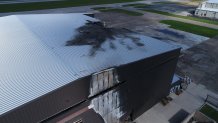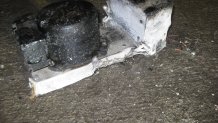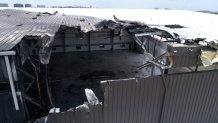The National Transportation Safety Board is investigating Sunday morning's plane crash at Addison Airport that claimed the lives of 10 people, including two children.
During a Monday press briefing, NTSB Vice Chairman Bruce Landsberg and lead investigator Dr. Jennifer Rodi said the twin engine Beechcraft BE 350 Super King airplane's landing gear was down when it crashed into a hangar at the suburban Dallas airport.
"The airplane was airborne, so the airplane veered to the left, started to roll to the left, rolling when it collided with the hangar," Landsberg said.
Rodi also revealed the entire plane made impact with the hangar, meaning it didn't fall apart in the air.
Investigators said the hangar's sprinkler system helped get the subsequent fire under control.
Local
The latest news from around North Texas.
Maintenance records also came into question during a press conference Monday afternoon.
"The FAA is now working on looking for the maintenance records for the aircraft. Anytime there is any maintenance done on an airplane it is documented by a certificated mechanic," Landsberg said.

The NTSB also was able to recover the plane's voice recorder. It captures communication between the pilots and their communication with air traffic control.
"We don’t know exactly what’s on the recorder, but what the recorders do will capture external communications between the crew and air traffic; and of particular interest to us is of the internal cockpit conversation between the pilot and the copilot," Landsberg said.

Landsberg said the "black box" is being analyzed in Washington, D.C., but added as far as they know communication seemed "completely normal" that day. The small plane was cleared for takeoff, the pilots acknowledged.
Landsberg said there was, however, no flight data recorder device in the plane, which would have aided in the investigation.
Personal-use planes like the one involved in the deadly accident are not required to have them, although the NTSB has recommended it to the FAA, Landsberg said.
This means the NTSB will "take the long road" and rely heavily on the wreckage and especially on security video that captured the entire event.

Investigators have spoken with just a few people who witnessed the horrific crash, including a longtime local pilot.
David Snell was readying for his own flight Sunday morning to catch breakfast with friends when he witnessed the accident.
"My friend and I have flown for a long time," he said. "We both knew that the sound that we were hearing out of that King Air was not correct."
Snell grabbed his cell phone and captured the horrific aftermath.
"It appears as though the airplane stalled and it fell to the left, and when that happens at a low altitude it's impossible to recover," he said.
Snell said he remembers hearing both engines running, but at a lower power setting.
"If you have a house fan: Speed one is low, speed four is high. When you're taking off you should be at a three or four, and this sounded like it was at a one or a two," he said. "But it didn't sound like it was one engine operating at a high speed, like as if they lost one."
According to Snell, the plane was simply too low and too slow on takeoff.
"Being a pilot, all of us can relate to incidents, accidents — we try to learn from them, but to see it happen in front of you and know that there's a loss of life that's going to take place and there's not anything you can do about it, it's pretty traumatic actually," he said.
The NTSB is going to recover maintenance records for the aircraft; annual inspections are required.
The plane was two years old, according to the NTSB.
Investigators will also look at the pilot and his co-pilot's training records. Pilots are required to have specific training to operate this specific aircraft.
A preliminary report is expected to be released by the NTSB in two weeks.



